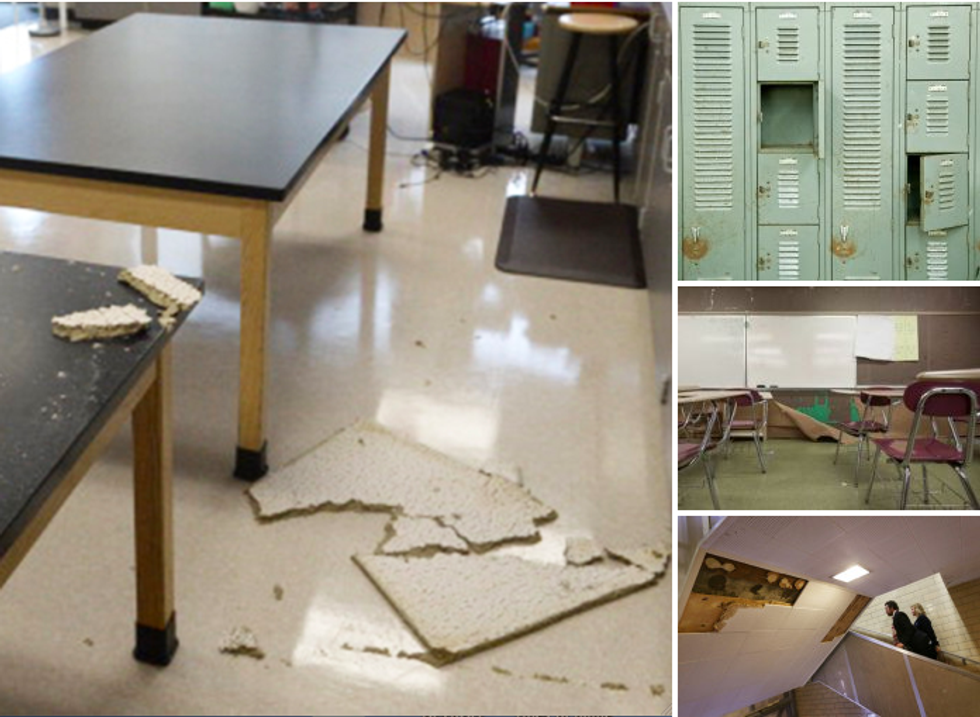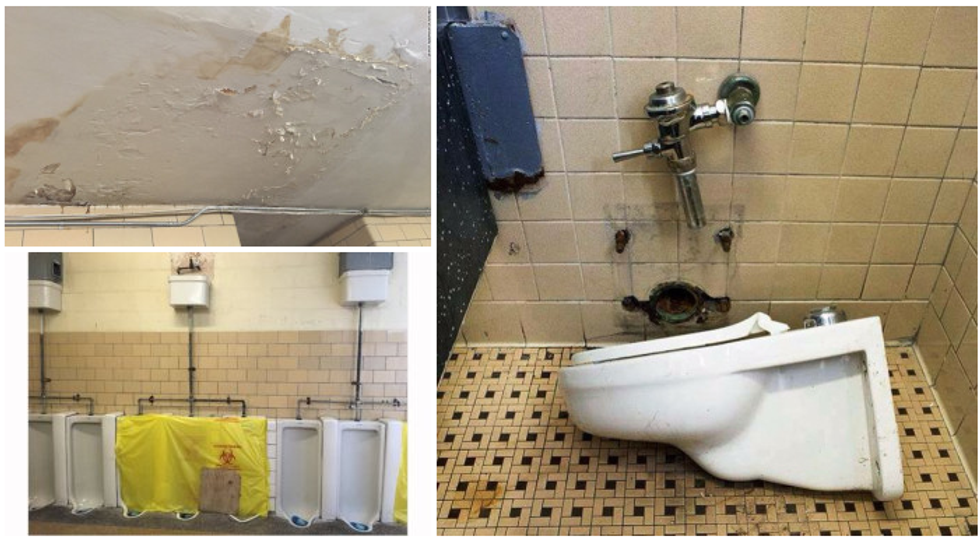Donald Trump lies.
If you haven't learned that yet, America, you've got four more cringe-inducing years to do so.
Even in his inaugural address, he couldn't help but let loose a whooper about US public schools.
"Americans want great schools for their children, safe neighborhoods for their families and good jobs for themselves," he said. "But for too many of our citizens, a different reality exists. ... An education system flush with cash but which leaves our young and beautiful students deprived of all knowledge."
To which nearly every poor, nonwhite public school parent, student and teacher in the country replied, "What's that heck did he just say now!?"
Los Angeles Unified School district routinely has broken desks and chairs, missing ceiling tiles, damaged flooring, broken sprinklers, damaged lunch tables and broken toilet paper dispensers.
They're flush with cash!?
New York City public schools removed more than 160 toxic light fixtures containing polychlorinated biphenyls, a cancer causing agent that also hinders cognitive and neurological development. Yet many schools are still waiting on a fix, especially those serving minority students.
They're flush with cash!?
At Charles L. Spain school in Detroit, the air vents are so warped and moldy, turning on the heat brings a rancid stench. Water drips from a leaky roof into the gym, warping the floor tiles. Cockroaches literally scurry around some children's classrooms until they are squashed by student volunteers.
They're flush with freakin cash!?
Are you serious, Donald Trump!?
And this same picture is repeated at thousands of public schools across the nation especially in impoverished neighborhoods. Especially in communities serving a disproportionate number of black, Latino or other minority students.
In predominantly white, upper class neighborhoods, the schools often ARE "flush with cash." Olympic size swimming pools, pristine bathrooms - heck - air conditioning! But in another America across the tracks, schools are defunded, ignored and left to rot.
A full 35 states provide less overall state funding for education today than they did in 2008, according to the Center on Budget and Policy Priorities, which focuses on reducing poverty and inequality. Most states still haven't recovered from George W. Bush's Great Recession and the subsequent state and local budget cuts it caused. In fact, over the same period, per pupil funding fell in 27 states and still hasn't recovered.
And the federal government has done little to help alleviate the situation. Since 2011, spending on major K-12 programs - including Title I grants for underprivileged students and special education - has been basically flat.
The problem is further exacerbated by the incredibly backward way we allocate funding at the local level which bears the majority of the cost of education.
While most advanced countries divide their school dollars evenly between students, the United States does not. Some students get more, some get less. It all depends on local wealth.
The average per pupil expenditure for U.S. secondary students is $12,731. But that figure is deceiving. It is an average. Some kids get much more. Many get much less. It all depends on where you live. If your home is in a rich neighborhood, more money is spent on your education than if you live in a poor neighborhood.
The U.S. is one of the only countries in the world - if not probably the ONLY country - that funds schools based largely on local taxes. Other developed nations either equalize funding or provide extra money for kids in need. In the Netherlands, for example, national funding is provided to all schools based on the number of pupils enrolled. But for every guilder allocated to a middle-class Dutch child, 1.25 guilders are allocated for a lower-class child and 1.9 guilders for a minority child - exactly the opposite of the situation in the U.S.
So, no. Our schools are not "flush with cash." Just the opposite in many cases.
But what about Trump's other claim - the much touted narrative of failing schools?
Trump says our schools "leave... our young and beautiful students deprived of all knowledge."
Not true.
Graduation rates are at an all-time high of 83.2 percent. Moreover, for the first time minority students are catching up with their white counterparts.
It's only international comparisons of standardized test scores that support this popular myth of academic failure. And, frankly, even that is based on a warped and unfair reading of those results.
It depends on how you interpret the data.
Raw data shows US children far from the top of the scale. It puts us somewhere in the middle - where we've always been for all the decades since they've been making these comparisons. Our schools have not gotten worse. They have stayed the same.
However, this ignores a critical factor - poverty. We've known for decades that standardized tests are poor measures of academic success. Bubble tests can assess simple things but nothing complex. After all, they're scored based on answers to multiple choice questions. In fact, the only thing they seem to measure with any degree of accuracy is the parental income of the test-taker. Kids from rich families score well, and poor kids score badly.
Virtually all of the top scoring countries taking these exams have much less child poverty than the U.S. If they had the same percentage of poor students that we do, their scores would be lower than ours. Likewise, if we had the same percentage of poor students that they do, our scores would go through the roof! We would have the best scores in the world!
Moreover, the U.S. education system does something that many international systems do not. We educate everyone! Foreign systems often weed children out by high school. They don't let every child get 13 years of grade school (counting kindergarten). They only school their highest achievers.
So when we compare ourselves to these countries, we're comparing ALL of our students to only SOME of theirs - their best academic pupils, to be exact. Yet we still hold our own given these handicaps!
This suggests that the majority of problems with our public schools aren't bad teachers, or a lack of charter schools and school choice. It's money, pure and simple.
We invest the majority of our education funding in rich white kids. The poor and minorities are left to fend for themselves.
This won't be solved by Trump's pick for Education Secretary, Betsy DeVos and her school choice schemes. In fact, that's exactly what's weakened public schools across the country by leaching away what meager funding these districts have left. Nor will it be solved by a demagogue telling fairy tales to Washington's credulous and ignorant.
We need to make a real investment in our public schools. We need to make a commitment to funding poor black kids as fairly as we do rich white kids.
Otherwise, the only thing flushed will be children's future.



